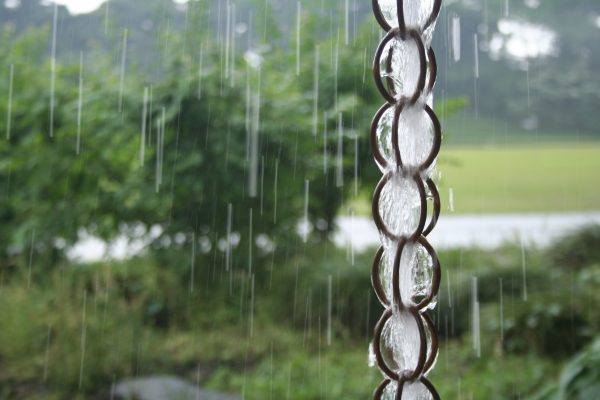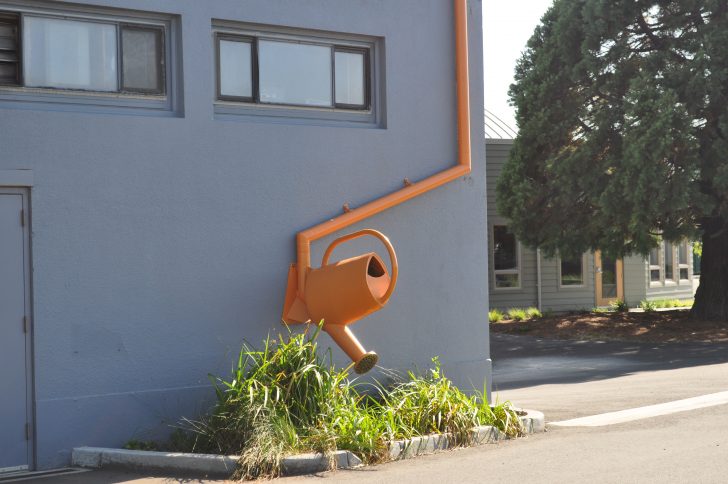Good design is in the details, as they say, and great architectural design details are often site-specific, responding to local contexts and regional conditions. In places like the Pacific Northwest where rain is a defining factor of everyday life, designing for drainage is naturally essential but it also represents an opportunity to get creative. And one way to do that is with a kind of drain pipe alternative called a “rain chain.”

Rain chains have a long history in Japan and have made their way around the world over time — essentially, they help guide water down off the sides of buildings without the use of pipes. In some places, chains are cheaper or more easily obtained than modern machined downspouts. More sophisticated versions can feature sets of cups linked vertically, turning drainage into a visual and auditory experience while also slowing water down (to help reduce erosion below). They also can’t get clogged by ice in areas with cold winters like pipes.
Rain chains have become increasingly popular as a reaction against downspouts, which 99pi fan Clifton Stone of Bend, Oregon argues “are ugly and are therefore routed inward under eaves to run down an outer wall.” In contrast, “rain chains look great so they head straight down from the eaves, far out from the house.” In short: rather than trying to hide the process of draining rain, chains highlight it.
“Perhaps the most difficult part of rain chain ownership, if there is one, is settling on a design,” writes Matt Hickman of MNN. “At their most simple, rain chains consist of a strand of traditional chains or large loops but can also incorporate a touch of whimsy with cups or funnels in the shape of things like watering cans, flowers and umbrellas. And in addition to copper, you can find rain chains made from materials like stainless steel or bamboo.” It all depends on the desired look.

In a way, it’s not really a question of showing or concealing drainage — conventional downspouts are visible as well, even if designed to blend in through material or color choices. Instead, it comes down to a question of what the process is going to look like. Functionally, downspout systems necessitate strange contortions, bending back in from roof-edge gutters to run down the sides of buildings, then jutting back out again to get water away from those same structures. In the end, they can wind up looking more prominent than hidden — for better or worse, they are the architectural equivalent of suit piping.

Rain chains are not the only way to mix things up on facades — other clever drainage solutions include an “instrument” (above) on the face of a building in Dresden, which plays “music” when it rains. In rain-heavy places like Seattle, some systems use pipes as planters (below), watering plants with rainwater as it makes its way down buildings.

Whatever the vertical system, there is also the question of what to do with rain once it reaches the ground. Some rain chains (or downspouts) hook into catchment systems for reclamation purposes. In other cases, water is led to rain gardens, which serve a variety of functions — these can improve water quality by filtering runoff, help with flood control, encourage biodiversity and tie buildings into their environments. A number of cities around the world have programs specifically designed to encourage rain garden development for these reasons.

Of course, none of these basic systems are new. The Harappan civilization used drains long before the Romans further innovated on plumbing. The Tower of London sported what may have been Britain’s first downspout as early as the 1200s, designed to help keep exterior walls clean. Early American settlers made gutters from sets of boarders connected to form a ‘V’ shape, replaced by cast iron in the 1800s then steel in the early 1900s (followed by plastic and aluminum).
Globalization, meanwhile, has made options like the Japanese rain chain more available around the world. The internet has also made it possible to find unique one-off solutions, like this handrail downspout.
If there is a larger takeaway here perhaps it is about paths of least resistance, with regards to both the actual flow of water and design decisions. On the one hand, it is easy to blindly follow regional precedents and traditions with long histories (or grab whatever is handy at the hardware store). On the other hand, sometimes it makes sense to take a step back and decide consciously how to reveal (or conceal) a natural process. For those seeking more inspiration, here are some more neat drainage ideas. (Special thanks to Doug Mack)



Comments (4)
Share
If you live in an area prone to tropical cyclones, though, make sure your rain chains are well-fastened so that they don’t become missile hazards.
Unfortunately rain chains would completely interfere with the walkways around our house… *sigh* I’ll just have to grow a vine up our downspout!
It was interesting to find out that rain chains are a great way to help guide water down the spouts without the usage of pipes. I like that they aren’t strictly just chains anymore, but owners can also opt to have more artistic touches to it such as funnels or watering cans. I’m interested in having my downspouts and overall drainage system fixed before the spring rains arrive, so I better look into that soon.
In Australia, the water from the sky is often desperately precious, even in the relatively rain-prone coast away from the desert. It’s odd to think that rainwater is thought of as something to get rid of, here many houses try to collect every drop, and store it in huge tanks around the house, for drinking, cleaning, watering the garden, or even defending the building from fires. The rain chain seems a splashy, wasteful way of redirecting the water, but very pretty.